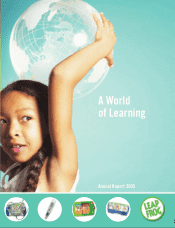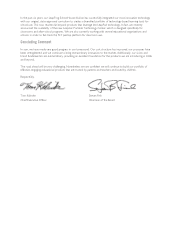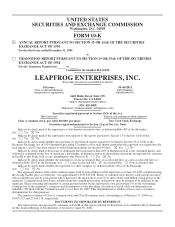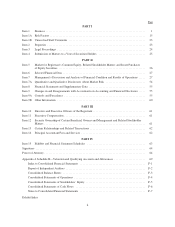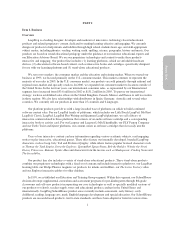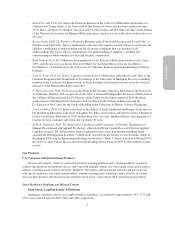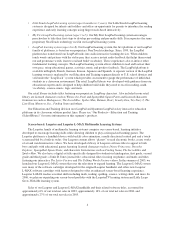LeapFrog 2005 Annual Report Download - page 9
Download and view the complete annual report
Please find page 9 of the 2005 LeapFrog annual report below. You can navigate through the pages in the report by either clicking on the pages listed below, or by using the keyword search tool below to find specific information within the annual report.
states and regions, including California, Illinois, Georgia, New York City and Texas. Our assessment and
instruction system, LeapTrack is designed to meet the increasing demands for accountability in schools. In
addition to our core instruction programs, our SchoolHouse division offers a library of interactive books to be
used with our LeapPad and Quantum LeapPad platforms, and which are designed to address challenging issues in
classroom instruction.
In 2005, we continued to support “Sed de Saber,” an English as a second language program in partnership
with Retention Education LLC. This program is aimed at teaching English to non-English speaking restaurant
workers to advance their careers.
Our net sales for our three business segments for the years ended December 31, 2005, 2004 and 2003, were
as follows:
Year Ended December 31,
% of Total Company
Net Sales
2005 2004 2003 2005 2004 2003
(dollars in millions)
U.S. Consumer ....................................... $478.3 $431.9 $546.0 74% 67% 80%
International .......................................... 131.2 153.2 96.6 20% 24% 14%
Education and Training ................................. 40.3 55.2 37.5 6% 9% 6%
Total Company ...................................... $649.8 $640.3 $680.0 100% 100% 100%
For additional discussion of our three business segments, see “Item 7. Management’s Discussion and
Analysis of Financial Condition and Results of Operations” and “Consolidated Financial Statements—Note 20.
Segment Reporting.”
We believe that sound educational principles are at the core of the value of our brands and products. Our
grade-based content is aligned with state and national education standards, often mirroring what is learned in the
classroom. All LeapFrog content and curriculum is based on a proprietary method of learning, created by our
in-house educational experts with the assistance of our Education Advisory Board, which identifies what children
learn and when and how they learn it. The members of our Education Advisory Board actively participate in the
design and development of our products by meeting with our creative design team several times each year. Our
Education Advisory Board also is an external source of feedback for our creative design team with respect to new
products that are in the development stage. We believe that both our in-house experts and outside advisors are
critical in the creation of our learning products.
Our Education Advisory Board
The members of our Education Advisory Board are extensively involved in the research of both education
and reading development. As of February 17, 2006, the members of our Education Advisory Board were:
•Robert Calfee, Ph.D. Dr. Calfee has chaired our Education Advisory Board since our business started in
1995. He has been a prolific researcher and author in the area of reading and reading development for
the past 30 years. Dr. Calfee is presently Distinguished Professor and Dean Emeritus at the School of
Education at the University of California, Riverside. He is professor emeritus at Stanford University’s
School of Education, as well as a member of the board of the Society for Scientific Study of Reading.
•Anne Cunningham, Ph.D. Dr. Cunningham is an associate professor of cognition and development at the
University of California, Berkeley and the Director of the Joint Doctoral Program in Special Education.
She is a past member of the board of the Society for Scientific Study of Reading and the board of
directors for American Educational Research Association, Division C.
2

